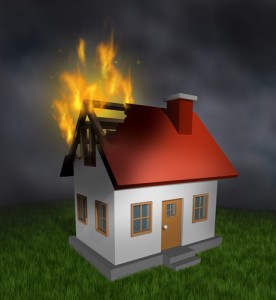In February, we published a Post about a Florida decision that aligned that state with the clear majority of American courts that have held that the destruction of property by an intentionally set fire is encompassed within the terms “vandalism and malicious mischief.” Last Friday, in Hung Van Ong v. Fire Ins. Exch., 2015 WL 1524464, 2015 Cal. App. LEXIS 290 (Cal.Ct.App., Apr. 3, 2015), two of the three justices on a California intermediate level appellate court panel rejected that approach, reversing a grant of summary judgment in favor of the insurer in a case in which a vacant dwelling had been damaged when a transient set a fire on the kitchen floor to warm himself because they concluded that there was no evidence of “actual ill-will or intent to injure.” In a considerably more convincing opinion, the third member of the panel dissented and argued that the trial court should have been affirmed.
 The policyholder had a rental property in a “relatively isolated location” that was vacated by the last tenant in February 2010. On December 20, 2011 the home was damaged by a fire. Subsequent investigation indicated that it was a “warming fire” set by a transient that got out of hand when he attempted to kick the burning firewood out the back door.
The policyholder had a rental property in a “relatively isolated location” that was vacated by the last tenant in February 2010. On December 20, 2011 the home was damaged by a fire. Subsequent investigation indicated that it was a “warming fire” set by a transient that got out of hand when he attempted to kick the burning firewood out the back door.
The contract of insurance excluded “direct or indirect loss from . . . Vandalism or Malicious Mischief . . . if the dwelling has been vacant for more than 30 consecutive days.” The term “vandalism” was not defined in the policy. The insured’s claim was denied, and the policyholder brought suit in March of 2012. After the trial court granted Fire Insurance Exchange’s motion for summary judgment, an appeal followed.
On April 3rd, a divided panel of the California Court of Appeal reversed. Justice Victoria Chaney looked to a California Supreme Court case involving the requisite degree of malice for arson; as she explained, in that decision, the high court
stated that malice as “universally understood by the popular mind” involves “ill-will” and not simply a wrongful, intentional act done without justification, excuse or mitigating circumstances. . . . Thus, the reasonable interpretation of “vandalism” as used in the policy exclusion means malicious destruction or defacement where there is malice in fact or actual ill-will or intent to injure.
In her view, there was “a triable issue of fact as to whether the fire was intended to be destructive of property.” In addition, the majority rejected cases from other jurisdictions that had recognized that intentionally set fires satisfy the vandalism component of a vacancy exclusion because none of them “appear[ed] to involve an ‘uncontrolled warming fire’ or a ‘warming fire [that] got out of hand.’ “
Justice Frances Rothschild filed a vigorous and far more persuasive dissent. She noted that the dictionary definitions of the term vandalism that the majority cited defined the word to mean “willful or malicious destruction or defacement of public or private property” and that Justice Chaney’s opinion essentially ignored the willful component of that definition. In the dissenter’s view:
Vandalism thus need not be malicious, as long as it is willful. In this context, “willful” means “done deliberately” and is synonymous with “intentional.”
* * *
Starting such a fire would inevitably damage or deface the floor. It therefore constitutes vandalism under the Webster’s dictionary definition. And it does not matter that the person who started the fire did not intend for it to become as destructive as it did. The insurance policy exclusion applies to both direct and indirect loss from vandalism. Starting the fire was vandalism (because it was willful destruction or defacement), so the loss resulting from the fire is not covered.
It also does not matter that the person who started the fire did it to keep warm. What is relevant is that someone intentionally started the fire on the kitchen floor, which constitutes willful destruction or defacement of property.”
Justice Rothschild also pointed out that the policyholder was essentially seeking to recover benefits “for which he did not pay.” The fire set by a transient is exactly “the kind of willful destruction that becomes much more likely when the property is left vacant for an extended period.” As a result, it is “the kind of thing to which the exclusion ought, in fairness, to apply.”

